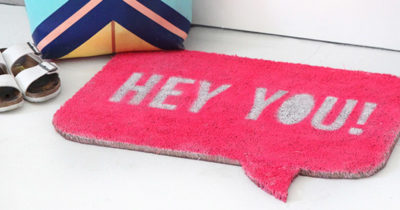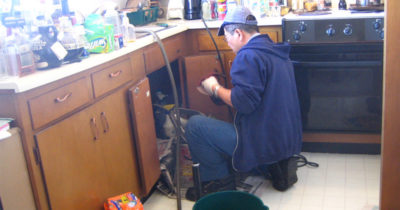Basic Plumbing Tips For New Homeowners
This post contains affiliate links; if you buy something we get a small commission at no extra cost to youSo you’ve just bought a home or moved into a new one.
And there’s a lot to learn!
You may have briefly considered the plumbing as you walked through the pre-purchase home inspection, and as long as the plumbing worked correctly at that time, there’s a chance that you’ve long put pipes, toilets, sinks and water lines out of your mind.
Most people never think about the plumbing in their home until they see water shooting from a pipe under a sink. Or a toilet clogs. Or their water pressure suddenly drops so low they can’t take a shower.
But there’s always something to check up whether it’s some spring cleaning or towards the new year when it gets cold: the perfect time to consider winter plumbing issues and take steps to make sure your plumbing is prepared.
If you live in a climate that is warm year-round, you are fortunate to never need to worry about freezing pipes or pipes bursting from cold weather.
Before you find yourself in a leaky situation it’s a good idea to learn about the plumbing in your home and stock up on a few handy items.
This way you’ll be prepared if you spring a leak or have a commode that refuses to flush.

Tools That All Homeowners Should Have
Every single person who owns property needs to have a toolbox stocked with the basic tools for minor home repairs.
These tools are really basic and super simple. They might include tools for hanging pictures, replacing kitchen cabinet handles and yes, even tools for DIY plumbing.
You never know when you may need to tighten a hose, replace a sink faucet or reseal a pipe that has a little leak. Even if you’ve never done any of this before it still helps to have the tools around so you can show them to the plumber that schleps over.
He likely has his own, but he can at least show you how to fix similar problems in the future. Never hurts to learn from a pro!
All that said, you might want to add the following tools into your toolbox.
- Plumbers Putty– Not necessarily a tool, but when a sink drain needs to be resealed in the middle of the night it’s good to have some plumbers putty on hand.
- Plumbers Tape– Another great item to stock up on is plumbers’ tape. If you want to put in a new showerhead, or replace an old pipe under the sink, plumbers’ tape can help prevent leaks.
- Locking Pliers– When you need a good grip on a pipe under the sink you’ll be glad you have some locking pliers.
- Caulk Gun– Caulk around a tub or sink does not last forever. When you need to repair or replace the caulk it is best to use a caulk gun so you can get an even line of caulk all the way around.
Preventing Plumbing Problems
Pipes get old and they bust.
There will be times when toilets clog, hoses leak, and water pressure gauges need to be replaced.
And while you cannot stop all plumbing disasters, it is possible to stay proactive and do things to help prevent problems before they happen.

A few tips here that newer homeowners should definitely pay attention to:
Drains
– Never pour grease like cooking oils down the drain. They can harden and cause your pipes to clog.
– Clean the drains at least once a month with a solution of vinegar and dish liquid. Be sure to run hot water to flush them out.
Toilets
– Never flush things like cleaning wipes, sanitary napkins, Q-Tip swabs, cotton balls or similar items down the toilet.
– If you have a septic system, be sure to use Rid-X or a similar septic system treatment product to help break down the household waste and restore the right balance of good bacteria and enzymes so your septic system will continue working.
– Be sure to replace broken handles and other tank parts if you notice they are wearing out. This is usually evident when you need to hold the handle down to completely flush or when the water does not stop running after the tank fills.
– Check for a leaky tank by adding a few drops of food coloring to the tank. Wait a few minutes and if color appears in the bowl, you have a leak.
In the Yard
– Check for leaks at outdoor faucets and get them repaired quickly. A leaky faucet can leak hundreds of gallons of water daily and can lead to high water bills or flooding.
– Check for standing water in the yard as this can be a sign of a busted sewer line or a busted pipe.
Water Valves
– The valves under your sink and behind the toilet should be checked a least every three months to make sure they are easy to turn off & on.
– Valves that are not checked frequently can begin to lock up and if you need to shut the water off in a hurry, you may find that the valve won’t turn easily. That’s a big oopsie just waiting to happen.
Sinks
– Check under the sink to make sure you have no leaks every so often.
– Check your faucets to make sure they turn easily and that there are no signs of water leaking from the faucet area.
– Low water pressure in a sink faucet may be a sign that the aerator has gone out and needs to be replaced. In most modern faucets, the aerator is permanently attached, so you will need to replace the faucet.
Water Heater
– You should make sure the temperature on your water heater is set at 120 degrees so it will be hot enough for showers, but won’t scald you in the tub.
– Every six months you should drain a few gallons of water from the water heater to remove sediment and help extend its life.
– Never store anything flammable near the water heater.

Types of Pipes You May Find in Your Home
Depending on how new(or old) your home is, you are going to find many different pipes made of many different materials.
It is a good idea to know what they are before you try to pry them apart. And it helps to share this info with your plumber so they know what to expect before showing up.
Cast Iron – In older homes cast iron piping was used for sewer lines. Chances are you will not find cast iron in a newer home.
Copper – Copper is often used for water supply lines and is very common.
Copper Tubing – Copper tubing is flexible and is often used for a water heater or cold-water supply.
PVC – PVC is a lightweight type of pipe that is typically used for waste pipes but not for water supply pipes. It is easy to cut to size and simple to piece together with other pipes with a little pipe glue.
ABS – Like PVC, only it is black in color. ABS is used for draining lines and vent lines. It is not used today but you may find some in older homes. When it’s time to update, ABS gets replaced with PVC.
PEX – PEX is used for water supply lines and is easy to cut, bends well and is simple for homeowners to use for DIY plumbing repairs around the home.
When Should You Call a Plumber?
Many homeowners call a plumber for situations they could easily fix on their own.
Plumbers can be expensive, so for small issues, you can DIY it and save a little money.
Let’s consider a couple simple situations to determine when you need to call a plumber to make the repair and when you may be able to do it on your own.
Clogged Toilets – Keep a plunger on hand to quickly unclog a toilet. If the toilet doesn’t flush immediately after plunging, don’t stress about it!
Grab a bucket with hot water and dish soap and try to flush it by quickly pouring the mixture down the drain.
You can also try using a long toilet snake to break the clog apart and flush the toilet. Or you may want to try using a Shop Vac(be sure it can be used in water) and suction the clog out.
If you try to unclog the toilet and it still won’t flush, you might need to admit defeat and call a licensed plumber to take care of it.
Clogged Sink – If you have kids, chances are you have experiences with pulling the P-Trap under the sink off to remove small toys or other messy clogs.
This is simple to do but you’re going to need a bucket to place under the pipe to catch the water (unless you don’t mind water pouring all over you & the floor).
Then you’d remove the pipe and clean out the mess before replacing the pipe. If the clog has moved further into the pipe system, you may need to contact a licensed plumber for help.
Generally speaking a plumber is a good idea if you may screw something up so bad that you’d wind up paying more to a professional. But there is value in at least trying to solve the easy stuff on your own, without doing major damage, before throwing in the towel.
Everything comes in time as well so the longer you own a home the more you’ll face problems. And from those problems you’ll learn a whole lot about how your house works, plumber or not.













